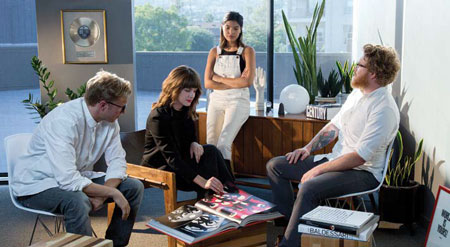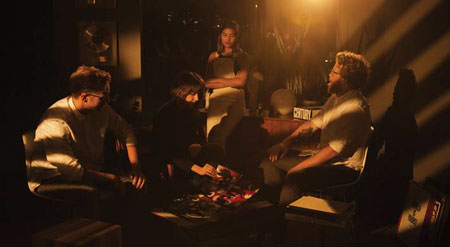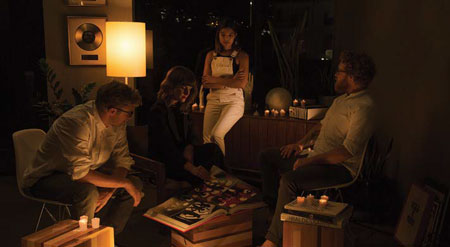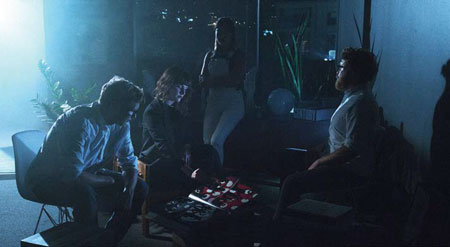The Power of Lighting
LOS ANGELES—A few months ago, Shots magazine did a special issue on the technical trades behind-the-scenes in the industry and they chose me to represent expertise in the world of lighting. For each piece in the issue, they wanted to demonstrate the trade: stunts showed the breakdown of an action sequence; foley showed beautiful photographs of the obscure objects that create amazing sounds; makeup took four people and made them all look like one person. The challenge was to take a single scene and light it four completely different ways to show the power and versatility of lighting.
After discussion with the creative team at Shots, it was decided that my approach would be a neutral afternoon natural daylight look, a surrealistic noir look, a night time candle romantic look and, finally, a horror look.
Because I’m a bit of a freak, I also decided to accomplish these looks with the most minimalistic equipment and crew that I could—further demonstrating my constant mantra that you can do more with less. We shot the scenes at the office of Bartle Bogle Hegarty Inc., the creative agency that was managing the issue. I came with my usual kit: two 4-foot x 4-bank Kino Flo fixures, one 1K Fresnel, three 650K Fresnels, two 150W Fresnels, four LitePanels Croma fixtures and one assistant, Roman Negrette.
Photographer Nolwen Cifuentes was on set to shoot the results of my work.

Set lit for natural daylightDAYLIGHT LOOK
In order to get three night looks, we started work late in the afternoon. So we naturally started with the daylight look. We wanted a realistic feeling, but not too high key, keeping it moody.
The wall in the background, outside the windows at frame right, is all lit by natural light from the sun. The windows in the office had a northwest exposure, but close buildings blocked any direct sunlight from entering the office. I really liked the base look of the natural daylight and we decided to go a little cool with that by setting the camera to a mid-range color temp of about 4300K. I started with filling in the shadows a little bit by bringing in the 4’ x 4-bank Kino Flo with 5500K daylight tubes, just to the left and above camera. I then brought in several tungsten Fresnels and used them as my hard, late-afternoon sunlight.
I started with two 650W Fresnels in the far corner of the office (outside of frame left). The first 650W Fresnel edges the model named Gabbie, who is leaning against the credenza dressed in white overalls. It provides a hot halflight on her body, as well as the credenza and the ceramic hand in the background. This Fresnel also puts an edge on the gold record hanging on the wall and the plant just under it to add life to the background.
I added in a second 650W Fresnel that backlights Mary, the model in black as well as J.P.’s shoulder on the far right and the back of Tom’s head (seated far left). Finally, I put a 300W Fresnel outside the windows just behind the wall where the gold record hangs. I spotted that in to get a hot edge on the side of Gabby’s face and head.

Surrealistic noir lookHYPER-NOIR
The second look brings us into a bit of surrealism with a “hyper-noir” sunset. This is our biggest departure from reality as we wanted the venetian-blind effect, but the real sun would set behind the models. We waited until the real sun had set and I used a 650W Fresnel lamp just outside the window pointing into the room to give the “sun” highlight in the background, which would also flare the lens a bit. I then took 2-inch black gaff tape and stretched several pieces between two C-Stands to create an instant venetian blind that was lit from a 1K tungsten Fresnel. I removed the Fresnel lens to make it an open-face fixture and create a harder shadow from the blinds on the models. A small Litepanels Croma LED fixture is tucked under the credenza to help bring the background plant out of the shadows and bring in some background detail. The white balance of the camera was set to a very high 10,000 Kelvin to make the tungsten lights read very, very warm.

Set lit for a candlight eveningCANDLE LIGHT
Our third look was a late-night candlelit feel. We started by placing the candles around the set, but these were very small candles with very small wicks and we didn’t get much light out of them at all. To get the feel of candle light, I wanted to edge light the models from low angles. This starts with a 150W Fresnel fixture that is bounced into a silver reflector on the floor, placed at the feet of Tom (far left). This uplights Tom with an organic breakup pattern that feels like it’s actually coming from the candles. I did the same thing with J.P. (far right), but because of the wooden blocks and books, the bounce was further away and the effect wasn’t as significant. For Mary and Gabby, I placed a pair of Litepanels Croma fixtures, dialed down to tungsten color balance, hidden behind J.P.’s body to give the ladies their low edge light. Finally, the practical lamp has a 150W bulb dimmed down to make it nice and warm.

... and night of horrorTHE HORROR
Finally, our last look was a “horror” feel. I started with the 1K Fresnel (with the lens back in) outside the window, flooded to cover most of the room with backlight and I put full CTB on the fixture. Inside, I kept one of the Litepanels Croma fixtures tucked in behind J.P. and dialed the color temperature to 5500K to match the blue of the backlight. Adding a generous amount of atmosphere into the room from a small glycol fogger helped to spread a little of the backlight into the shadows so we could get a better look at the talent, even in the dark.
Overall, this challenge was a lot of fun. I wanted to do it all with a very small lighting package that required nothing more than standard house power. For each lighting challenge, I wanted to accomplish them as simplistically as I could, yet create completely different moods. The candle light shot used the most fixtures (five), but I only used three fixtures for the daylight and two lights for both the noir sunset and the horror. Lighting doesn’t have to be complicated to tell a story.
All of the techniques I used, and more, are included in my book “Behind the Lens: Dispatches from the Cinematographic Trenches,” available from Focal Press. Find it and my first book “A Shot in the Dark: A Creative DIY Guide to Digital Video Lighting on (Almost) No Budget,” on Amazon.com and booksellers everywhere.
Get the TV Tech Newsletter
The professional video industry's #1 source for news, trends and product and tech information. Sign up below.
